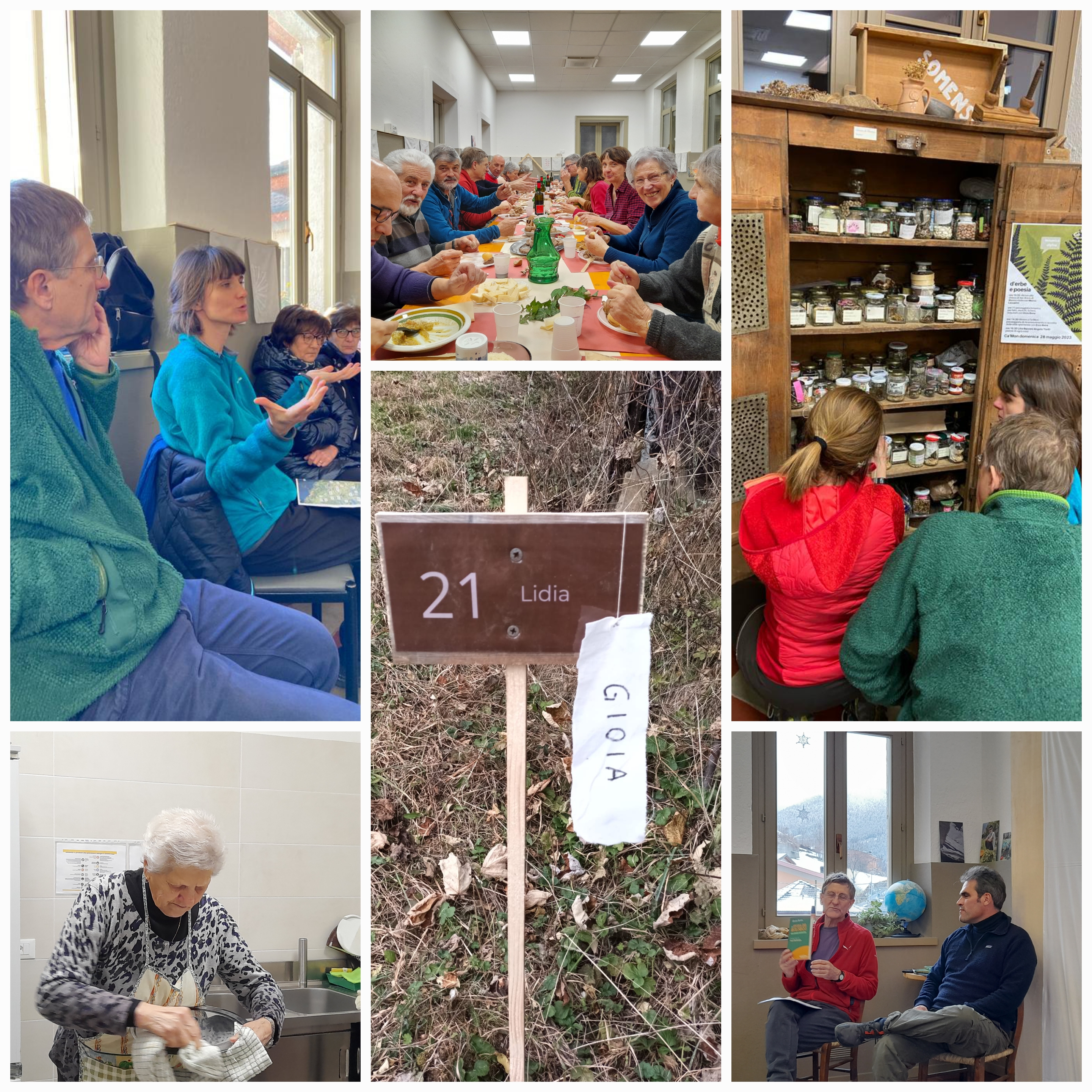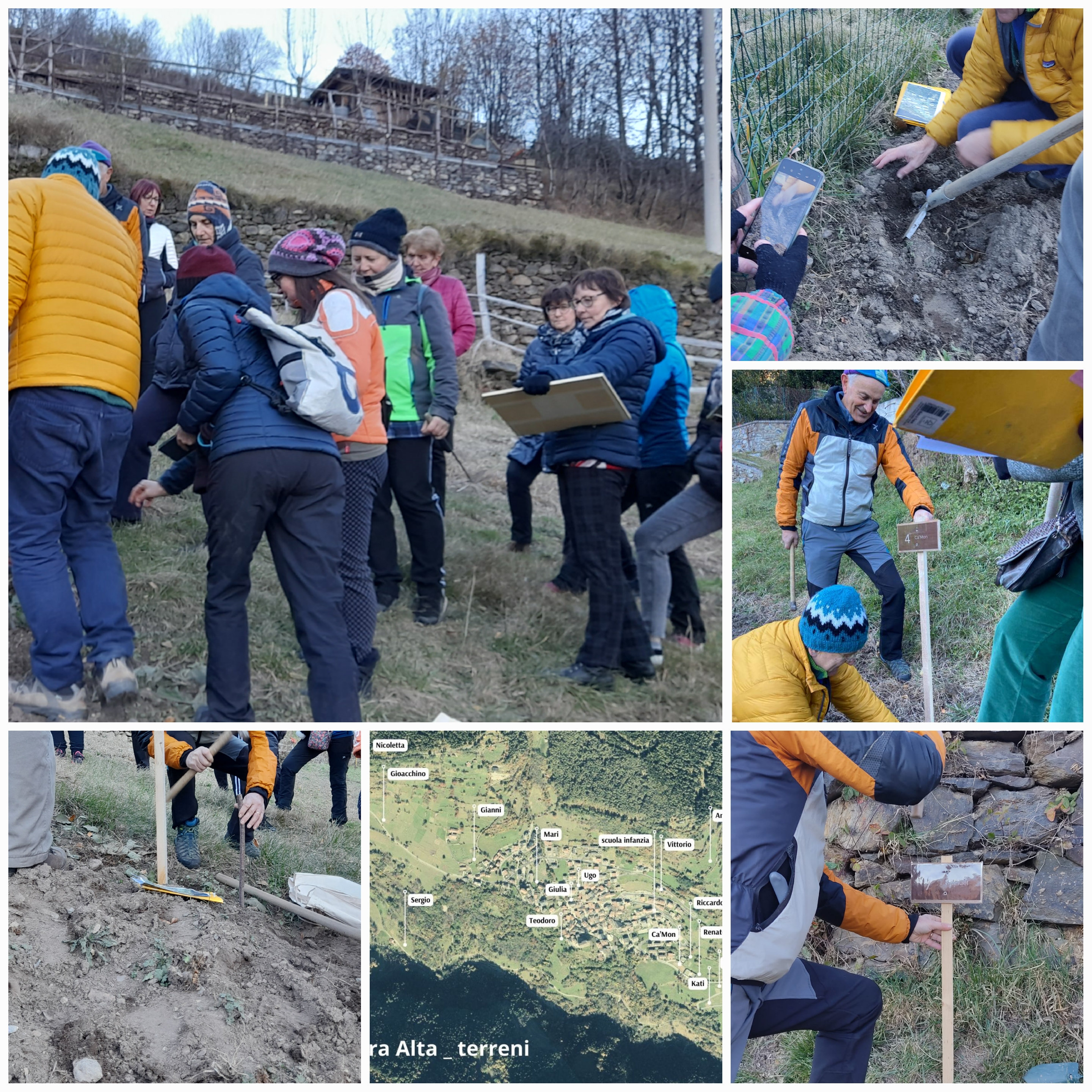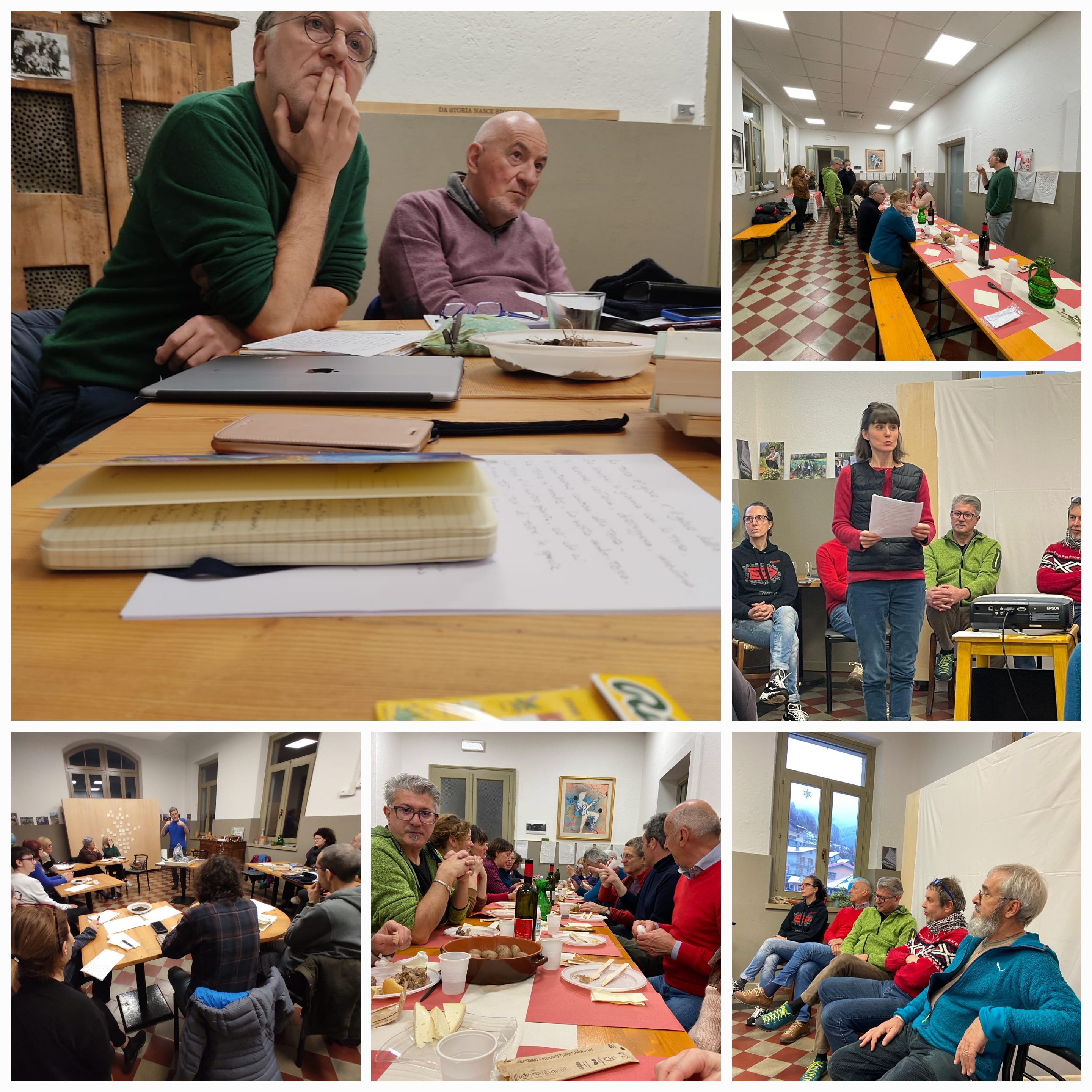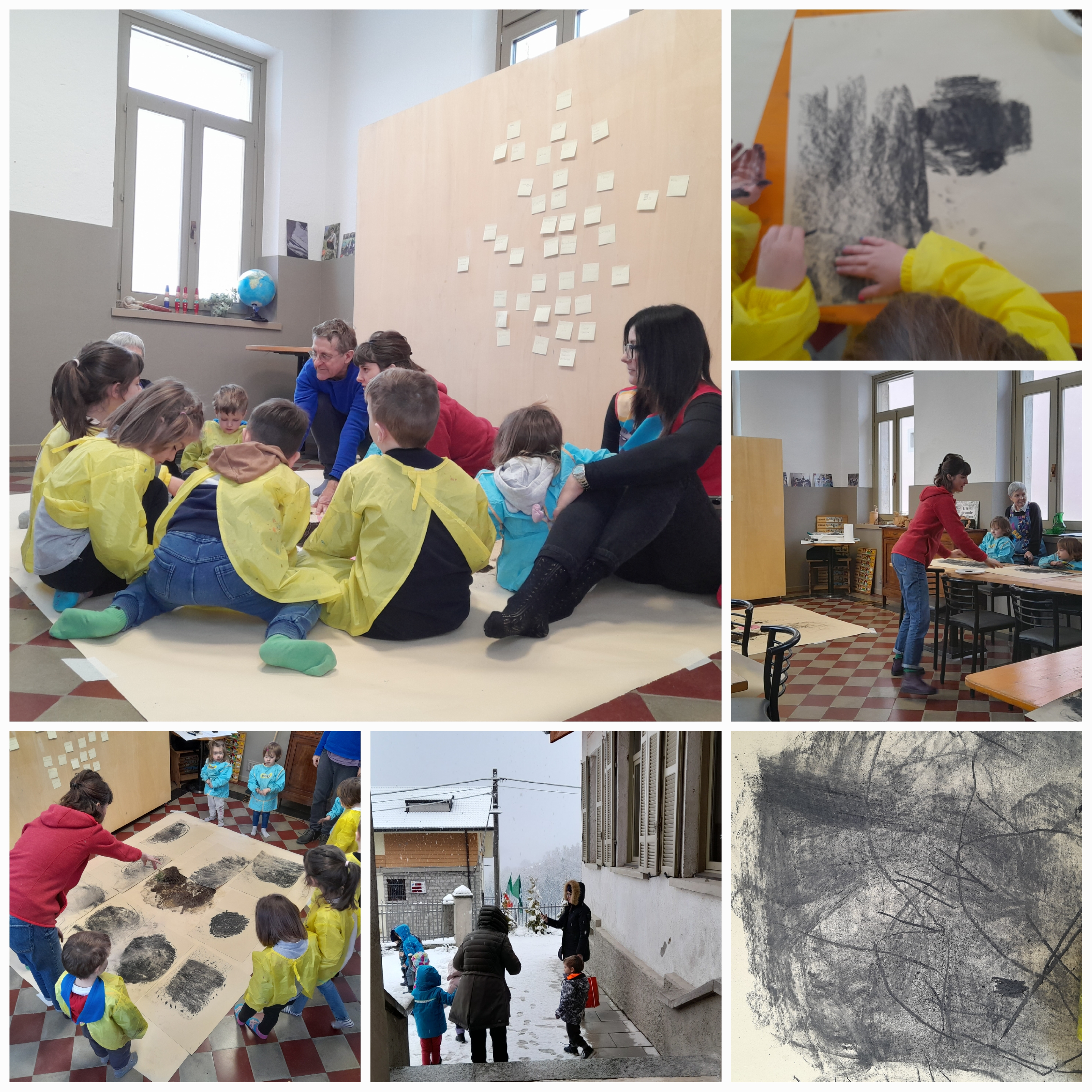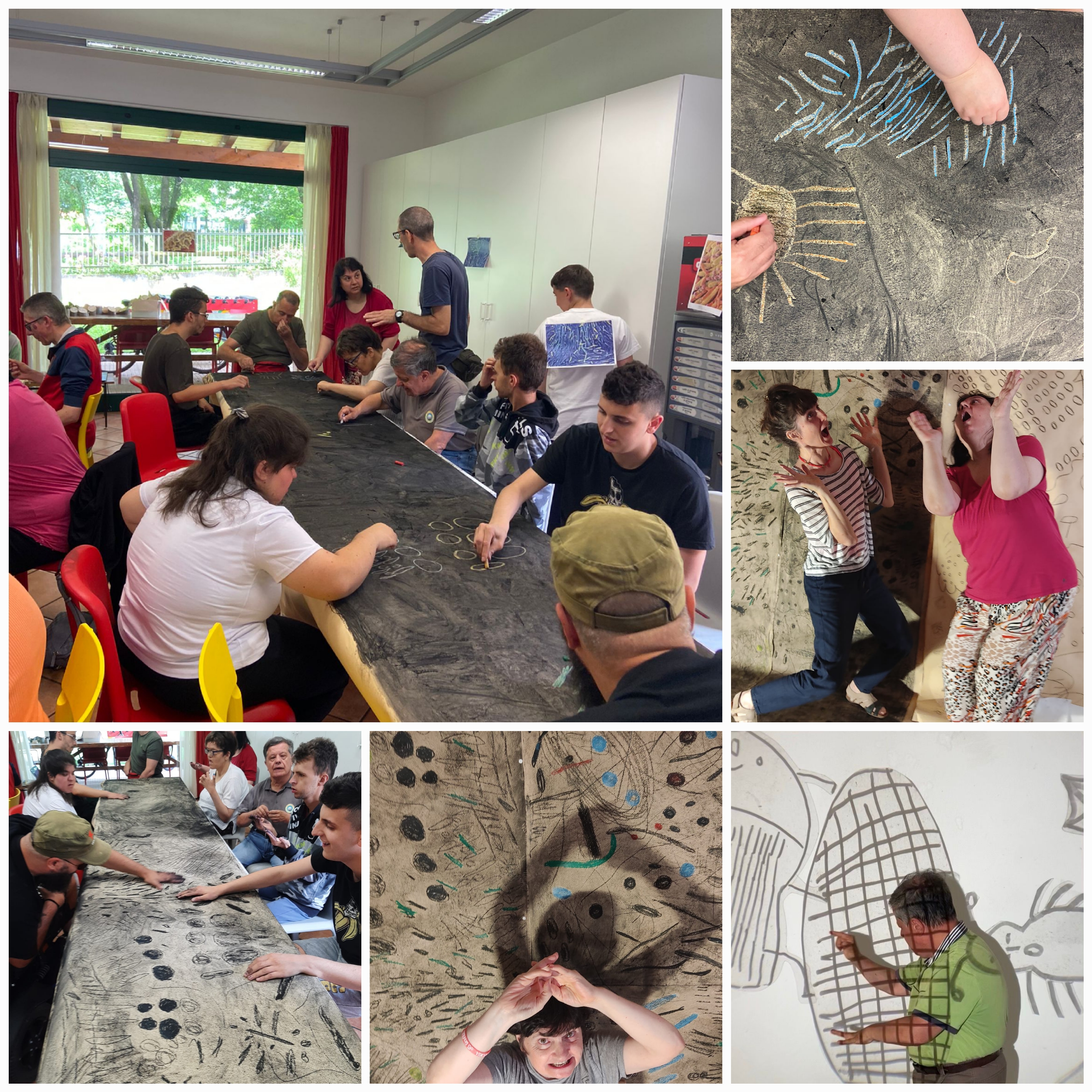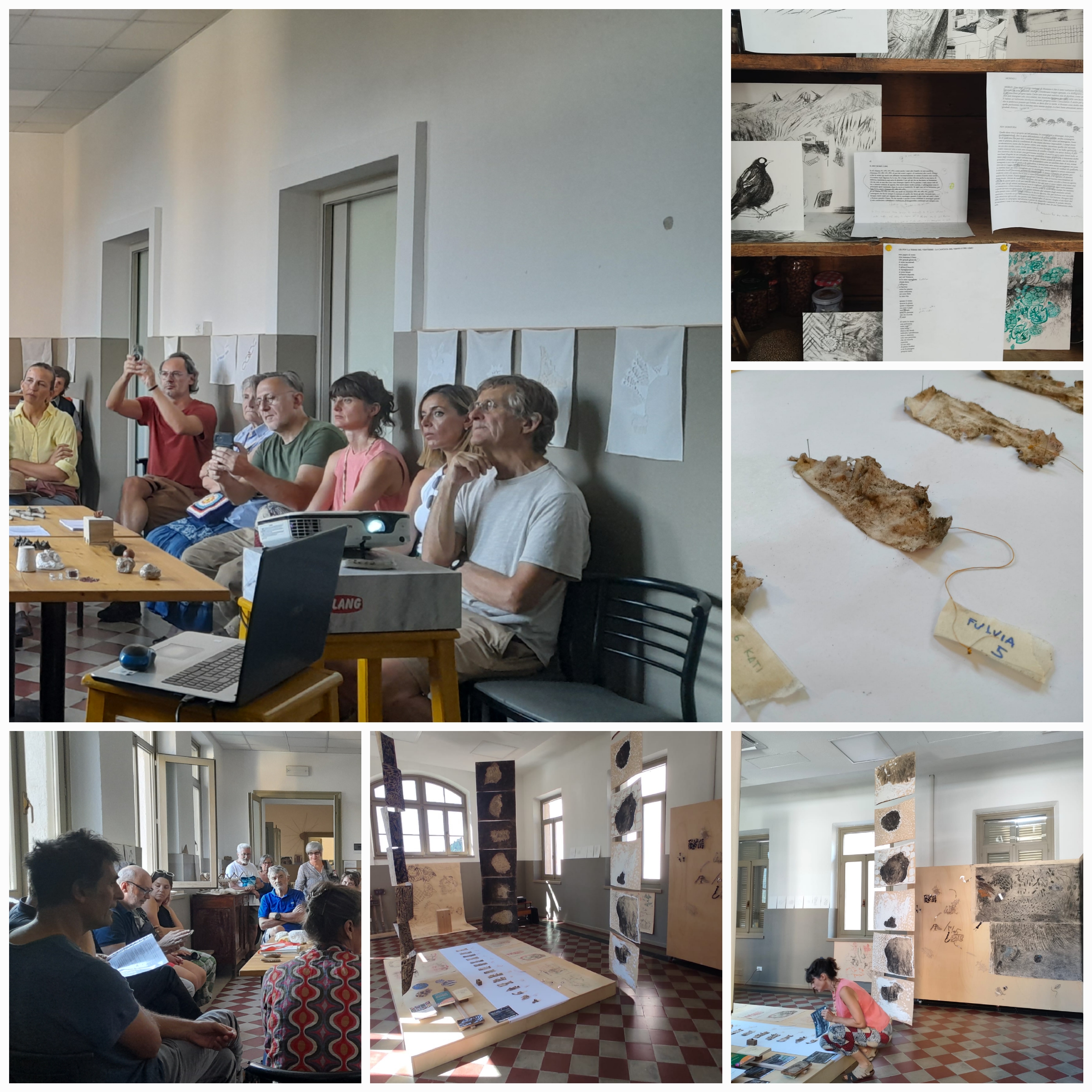Reconnecting with nature
Roots of Change
How soil can help us grasp and tackle Climate Change?
One year ago we imagined that we could choose as the pivotal theme of the regeneration of a village in the Italian Alps called Monno the relationship with the earth (soil), preserved and cared for by the community, in a residual form from an economic point of view, but central from the point of view of the sense of belonging to places. We imagined an artistic residency capable of setting in motion a long process of re-significationable to bring together the hidden energies of the community
Italy
Local
Monno (BS), Camonica valley, Alpine valley
Mainly rural
It refers to other types of transformations (soft investment)
Yes
2024-12-31
No
No
No
As a representative of an organisation, in partnership with other organisations
In line with the NEB Prizes 2025 , which celebrates projects that foster sustainable living and inclusive cultural and artistic expressions, Ca'Mon Community Center in Monno (BS), Italy, has launched a powerful, year-long artistic residency from October 2023 to December 2025. This initiative brings together the creativity of a writer and a visual artist, working closely with the local community to explore the often overlooked theme of soil and its fertility, rethinking our relationship with the land we depend on.
The residency and its associated activities embrace the NEB's commitment to sustainability by focusing on agroecology, land stewardship, and environmental consciousness. Through workshops aimed at children and adults, participants explore how soil—an essential, yet invisible resource—shapes our lives. The workshops prompt reflection on the profound and invisible connection between people and the earth, while encouraging more sustainable practices and communication about the land.
In this process, community members are invited to question: What compels us to preserve uncultivated land? What drives us to continue agriculture despite its challenges? How can we, through creative writing and visual arts, rethink our relationship with the soil, acknowledging its importance in our everyday lives?
The collaborative results of this artistic journey are encapsulated in the book Rasoterra, published by Cooperativa Il Cardo. This multidisciplinary and inclusive work brings together written word, visual art, and collective community insight, reflecting the sustainable, inclusive, and creative dimensions of the NEB. The book invites readers to explore themes of soil, fertility, and our deeper connection to the land, with an emphasis on cultural and environmental resilience.Located in the Italian Alps, Ca'Mon is a vibrant community center dedicated to art and craft opened four years it is a place wheresustainability, inclusivity and cultural innovation come together
The residency and its associated activities embrace the NEB's commitment to sustainability by focusing on agroecology, land stewardship, and environmental consciousness. Through workshops aimed at children and adults, participants explore how soil—an essential, yet invisible resource—shapes our lives. The workshops prompt reflection on the profound and invisible connection between people and the earth, while encouraging more sustainable practices and communication about the land.
In this process, community members are invited to question: What compels us to preserve uncultivated land? What drives us to continue agriculture despite its challenges? How can we, through creative writing and visual arts, rethink our relationship with the soil, acknowledging its importance in our everyday lives?
The collaborative results of this artistic journey are encapsulated in the book Rasoterra, published by Cooperativa Il Cardo. This multidisciplinary and inclusive work brings together written word, visual art, and collective community insight, reflecting the sustainable, inclusive, and creative dimensions of the NEB. The book invites readers to explore themes of soil, fertility, and our deeper connection to the land, with an emphasis on cultural and environmental resilience.Located in the Italian Alps, Ca'Mon is a vibrant community center dedicated to art and craft opened four years it is a place wheresustainability, inclusivity and cultural innovation come together
soil fertility
community driven change
art-driven ecological reflection
visual dialogue on sustainability
collective learning
The project aims to raise awareness among the inhabitants of the Alpine community where the Ca’Mon center is located about the biodiversity and life hidden in the soil. Often overlooked and underestimated, soil biodiversity plays a crucial role in sustaining ecosystems, agriculture, and overall environmental health. By fostering knowledge and appreciation of this invisible yet essential world, we encourage responsible stewardship of the land and a deeper connection between people and nature.
The project fits perfectly within the NEB's focus on ecological sustainability, as it directly addresses soil fertility, a key issue for ecological transition and sustainable agriculture. The community’s involvement in managing agroecological community fields helps restore soil health and promotes farming practices that respect the environment, reducing the negative impact of conventional methods.
The ongoing training for families with agroecology experts not only spreads sustainable knowledge but also promotes a circular economy model, where resources are managed responsibly, and the community becomes an active part of the ecological transformation process.
The creation of community fields based on agroecological principles is not only an act of environmental sustainability but also an act of social innovation, as it promotes new models of relationship between people and their environment. These spaces become centers for ecological culture and knowledge exchange, where community members meet, learn, and share experiences related to sustainability and responsible farming.
The project fits perfectly within the NEB's focus on ecological sustainability, as it directly addresses soil fertility, a key issue for ecological transition and sustainable agriculture. The community’s involvement in managing agroecological community fields helps restore soil health and promotes farming practices that respect the environment, reducing the negative impact of conventional methods.
The ongoing training for families with agroecology experts not only spreads sustainable knowledge but also promotes a circular economy model, where resources are managed responsibly, and the community becomes an active part of the ecological transformation process.
The creation of community fields based on agroecological principles is not only an act of environmental sustainability but also an act of social innovation, as it promotes new models of relationship between people and their environment. These spaces become centers for ecological culture and knowledge exchange, where community members meet, learn, and share experiences related to sustainability and responsible farming.
The project incorporates aesthetic innovation through the participatory artistic process, involving two authors (a writer and a visual artist). These professionals contribute to creating a visual and literary narrative that explores the theme of land and soil fertility, making sustainability not just a practical issue but also an emotional and cultural one. This approach helps the community reflect on the importance of soil and agriculture in a profound and creative way.
Art becomes a tool to stimulate collective reflection, fostering emotional and cultural connections with the natural environment, which is a key aspect of NEB policies. Art is seen as a way to improve quality of life and make sustainability more tangible and accessible to everyone.
The aesthetic and visual approach proposed by the authors (the writer and the visual artist) helps to integrate aesthetics with sustainability, making the ecological process not only a topic of learning but also a matter of visual and narrative reflection. The community is invited to participate not only on a practical level but also emotionally and intellectually, through storytelling and art, creating a shared vision of how the future can be better through the care of the land and its resources.
Art becomes a tool to stimulate collective reflection, fostering emotional and cultural connections with the natural environment, which is a key aspect of NEB policies. Art is seen as a way to improve quality of life and make sustainability more tangible and accessible to everyone.
The aesthetic and visual approach proposed by the authors (the writer and the visual artist) helps to integrate aesthetics with sustainability, making the ecological process not only a topic of learning but also a matter of visual and narrative reflection. The community is invited to participate not only on a practical level but also emotionally and intellectually, through storytelling and art, creating a shared vision of how the future can be better through the care of the land and its resources.
A central element of the project is active community involvement, reflecting NEB principles of participation and inclusivity. Families are not just beneficiaries but actively engage in learning and managing the fields, creating a deep connection with the land and a collective sense of responsibility for its sustainability.
The co-creation and participatory process is further strengthened by the collaboration with experts and the participation of people in continuous training, ensuring that all community members, regardless of background or previous education, have equal opportunities for learning.
The collaboration between the agricultural and cultural sectors (through the writers and artists) is an example of how NEB promotes cultural innovation, where different disciplines and sectors intersect to create meaningful and lasting experiences.
The project carried out an intergenerational dialogue process, engaging the population across different age groups, from children to elderly custodians of traditional natural knowledge. It also included vulnerable individuals, such as people with disabilities and isolated elderly individuals. More broadly, inclusion was pursued with the aim of creating an educational community capable of responding to climate change and making conscious choices. The project fostered an environment where diverse experiences, perspectives, and voices were valued, ensuring that all participants, regardless of background, had the opportunity to contribute meaningfully to the collective learning and action process.
The co-creation and participatory process is further strengthened by the collaboration with experts and the participation of people in continuous training, ensuring that all community members, regardless of background or previous education, have equal opportunities for learning.
The collaboration between the agricultural and cultural sectors (through the writers and artists) is an example of how NEB promotes cultural innovation, where different disciplines and sectors intersect to create meaningful and lasting experiences.
The project carried out an intergenerational dialogue process, engaging the population across different age groups, from children to elderly custodians of traditional natural knowledge. It also included vulnerable individuals, such as people with disabilities and isolated elderly individuals. More broadly, inclusion was pursued with the aim of creating an educational community capable of responding to climate change and making conscious choices. The project fostered an environment where diverse experiences, perspectives, and voices were valued, ensuring that all participants, regardless of background, had the opportunity to contribute meaningfully to the collective learning and action process.
Community involvement is at the heart of the project. Initially, local residents offered their lands for a participatory and seasonal soil fertility test. Each participant buried a tea bag in winter and retrieved it in early spring, marking their land with a recognition sign. During visits to the land, participants were invited to describe their relationship with the soil in a single word.
While waiting for results, artists engaged school children and members of the social cooperative Il Cardo in visual research workshops dedicated to soil life. They explored questions such as: How do I represent invisible soil life? How do I depict the microscopic world? How does my perception of clean and dirty influence my representation of the earth? What living creatures do I know inhabit the underground?
In parallel, adults participated in a collective writing process to find the right words to describe soil and their personal connection to it. Alongside these workshops, meetings with experts in agroecology, ecological history, ecological market analysis, and family horticulture practices were organized.
As a result of this project, participants gained agroecological skills that they could apply to their own land. They learned to collaborate with others and to see knowledge as a shared resource, fostering a sense of community and mutual support. Moreover, they rediscovered the value of uniting around a common goal—the preservation of soil biodiversity.
While waiting for results, artists engaged school children and members of the social cooperative Il Cardo in visual research workshops dedicated to soil life. They explored questions such as: How do I represent invisible soil life? How do I depict the microscopic world? How does my perception of clean and dirty influence my representation of the earth? What living creatures do I know inhabit the underground?
In parallel, adults participated in a collective writing process to find the right words to describe soil and their personal connection to it. Alongside these workshops, meetings with experts in agroecology, ecological history, ecological market analysis, and family horticulture practices were organized.
As a result of this project, participants gained agroecological skills that they could apply to their own land. They learned to collaborate with others and to see knowledge as a shared resource, fostering a sense of community and mutual support. Moreover, they rediscovered the value of uniting around a common goal—the preservation of soil biodiversity.
A key element of the project’s success was the creation of a multi-level stakeholder network that provided critical support throughout its development. This network included:
Local farmers and landowners, who offered their land for experimentation and engaged in knowledge-sharing activities.
Educational institutions, which contributed to research and facilitated student participation in workshops.
Artists and cultural organizations, who helped visualize and communicate the hidden life of soil through creative expressions, as well as cultural institutions that contributed to disseminating the lessons learned through the presentation of the book and visual research developed within the project.
Scientific and environmental experts, who provided guidance on agroecology, biodiversity, and sustainable land practices.
Local policymakers and regional institutions, who supported the initiative by recognizing its value in fostering environmental awareness and sustainable development.
Community-based cooperatives and social enterprises, responsible consumer associations, community-supported agriculture groups, organic farmers' associations, and environmental protection organizations, which played a crucial role in organizing workshops, discussions, and community engagement activities.
By fostering collaboration between these diverse stakeholders, the project ensured a holistic and sustainable approach to soil biodiversity conservation. The multi-level stakeholder network enabled the integration of good practices in ecological agriculture, social farming, and the shared management of common resources between profit and non-profit entities. This approach not only strengthened the impact of the initiative but also laid the foundation for future partnerships and continued agroecological innovation.
Local farmers and landowners, who offered their land for experimentation and engaged in knowledge-sharing activities.
Educational institutions, which contributed to research and facilitated student participation in workshops.
Artists and cultural organizations, who helped visualize and communicate the hidden life of soil through creative expressions, as well as cultural institutions that contributed to disseminating the lessons learned through the presentation of the book and visual research developed within the project.
Scientific and environmental experts, who provided guidance on agroecology, biodiversity, and sustainable land practices.
Local policymakers and regional institutions, who supported the initiative by recognizing its value in fostering environmental awareness and sustainable development.
Community-based cooperatives and social enterprises, responsible consumer associations, community-supported agriculture groups, organic farmers' associations, and environmental protection organizations, which played a crucial role in organizing workshops, discussions, and community engagement activities.
By fostering collaboration between these diverse stakeholders, the project ensured a holistic and sustainable approach to soil biodiversity conservation. The multi-level stakeholder network enabled the integration of good practices in ecological agriculture, social farming, and the shared management of common resources between profit and non-profit entities. This approach not only strengthened the impact of the initiative but also laid the foundation for future partnerships and continued agroecological innovation.
The project embraces a multisensory approach, using:
Illustrations and writing to depict soil organisms in artistic and accessible ways, enhancing participants' understanding of the invisible world beneath their feet.
The combined expertise of a writer and a visual artist played a fundamental role throughout the community engagement process. Throughout the artistic process, the two artists hybridized their respective languages to create a unique narrative of a possible transformation for this place. Writing and illustration became the primary tools for reshaping the collective imagination of the underground world. These artistic languages not only fostered awareness of people's connection to the soil but also highlighted how this newfound awareness is deeply rooted in both the past—through ancestral agricultural traditions—and the future, where sustainability is key for the next generations. By blending artistic and scientific competencies, the project enabled participants to transform this awareness into conscious and enduring daily choices.
Immersive experiences, such as underground soundscapes and magnified imagery, engaging participants in new ways and prompting reflection on the intersection of perception, art, and environmental science.
The collaboration with researchers in cultural history and organic agriculture was a distinctive feature of the project. Addressing the development of a portion of territory from an agroecological perspective requires integrating expertise in agroforestry, family horticulture, evolutionary seed selection, and eco-sustainable economics to better understand consumers. Given that mountain regions are socially and environmentally fragile territories, this multidisciplinary approach was essential for fostering resilience and sustainable land management.
Illustrations and writing to depict soil organisms in artistic and accessible ways, enhancing participants' understanding of the invisible world beneath their feet.
The combined expertise of a writer and a visual artist played a fundamental role throughout the community engagement process. Throughout the artistic process, the two artists hybridized their respective languages to create a unique narrative of a possible transformation for this place. Writing and illustration became the primary tools for reshaping the collective imagination of the underground world. These artistic languages not only fostered awareness of people's connection to the soil but also highlighted how this newfound awareness is deeply rooted in both the past—through ancestral agricultural traditions—and the future, where sustainability is key for the next generations. By blending artistic and scientific competencies, the project enabled participants to transform this awareness into conscious and enduring daily choices.
Immersive experiences, such as underground soundscapes and magnified imagery, engaging participants in new ways and prompting reflection on the intersection of perception, art, and environmental science.
The collaboration with researchers in cultural history and organic agriculture was a distinctive feature of the project. Addressing the development of a portion of territory from an agroecological perspective requires integrating expertise in agroforestry, family horticulture, evolutionary seed selection, and eco-sustainable economics to better understand consumers. Given that mountain regions are socially and environmentally fragile territories, this multidisciplinary approach was essential for fostering resilience and sustainable land management.
Unlike mainstream actions that often focus solely on scientific research or environmental policy, this project uniquely blends artistic expression, scientific research, and community-driven participation. By integrating artistic storytelling, participatory experiments, and localized agroecological knowledge exchange, the initiative goes beyond traditional methods of ecological awareness. The use of hybrid artistic languages, the emphasis on multi-sensory experiences, and the deeply embedded community engagement set this initiative apart as a pioneering model for soil biodiversity conservation. This was made possible through the collaboration with community mediators, who played a key role in ensuring active participation. These mediators facilitated interactions between artists and the local community, engaging people of all ages—from children to the elderly—in creative workshops. Their role was essential in introducing the potential of artistic exploration, amplifying individual contributions, and fostering an inclusive and shared learning environment. The formation of this figure is shaped by their experience as a community activator—a project manager who navigates highly sensitive variables such as the age of participants, dialectical comprehension abilities, undisclosed talents, and the unspoken desires of the community. By continuously adapting the engagement process based on community responses, they ensure a dynamic, responsive, and truly participatory approach to ecological awareness and action.
By embracing the values of the New European Bauhaus, this initiative at Ca’Mon transforms knowledge into action, making the hidden world of soil biodiversity visible, appreciated, and protected for future generations.
By embracing the values of the New European Bauhaus, this initiative at Ca’Mon transforms knowledge into action, making the hidden world of soil biodiversity visible, appreciated, and protected for future generations.
The project prioritized bottom-up knowledge exchange, ensuring that learning took place in informal, participatory settings. Information was shared during communal meals, seed planting, soil preparation, and even bread-making sessions. Each meeting included a concrete case study from the valley, showcasing successful agroecological improvements. Many of these local initiatives were not widely known, despite their impact on restoring ecological balance in mountain territories.
By offering multiple ways to engage, the project ensured a broad and inclusiveparticipation, fostering both traditional and innovative knowledge-sharing methods.
A distinctive element of the project's methodology is the simultaneous development of processes on two levels—within the local community and across a network of local and supra-local stakeholders. This dual-level approach fosters the emergence of new skills and experiences within the community while also integrating innovative competencies and solutions tailored to small Alpine communities. By involving a broad range of participants, from local residents to external experts, the project continuously refines its practices and seeks adaptive solutions that are scalable and transferable. This multi-layered engagement ensures that knowledge and best practices are exchanged both horizontally (within the community) and vertically (through external expertise and institutional collaborations), enriching the project’s impact and sustainability.
By offering multiple ways to engage, the project ensured a broad and inclusiveparticipation, fostering both traditional and innovative knowledge-sharing methods.
A distinctive element of the project's methodology is the simultaneous development of processes on two levels—within the local community and across a network of local and supra-local stakeholders. This dual-level approach fosters the emergence of new skills and experiences within the community while also integrating innovative competencies and solutions tailored to small Alpine communities. By involving a broad range of participants, from local residents to external experts, the project continuously refines its practices and seeks adaptive solutions that are scalable and transferable. This multi-layered engagement ensures that knowledge and best practices are exchanged both horizontally (within the community) and vertically (through external expertise and institutional collaborations), enriching the project’s impact and sustainability.
Several aspects of the project are highly replicable and adaptable to different territories, communities, and cultural contexts:
Methodological Approach: The integration of artistic storytelling, scientific research, and participatory engagement can be applied to a wide range of ecological and community-based projects. The combination of illustration, writing, and hands-on workshops has proven effective in raising awareness and fostering behavioral change.
Community Activation Model: The role of the community mediator can be adopted in different contexts where public engagement is key. By training local mediators, other projects can ensure inclusive participation and continuous adaptation to community dynamics.
Multi-Stakeholder Collaboration: The networking model, which brings together farmers, scientists, educators, policymakers, and cultural institutions, offers a replicable framework for multi-level cooperation in environmental and social projects.
Participatory Learning Tools: The citizen science approach, such as soil fertility tests and biodiversity monitoring, can be easily transferred to other rural or urban settings.
Art-Science Hybridization: The use of art as a tool to communicate complex ecological concepts can be adapted for different environmental issues, from forest conservation to water management.
Knowledge Sharing Strategies: The project’s bottom-up, informal learning methods—such as storytelling, experiential workshops, and traditional knowledge-sharing practices—can be integrated into various educational and environmental initiatives.
By leveraging these elements, the project’s innovative blend of artistic and scientific approaches can inspire and empower other communities to develop locally grounded and culturally meaningful solutions for environmental sustainability.
Methodological Approach: The integration of artistic storytelling, scientific research, and participatory engagement can be applied to a wide range of ecological and community-based projects. The combination of illustration, writing, and hands-on workshops has proven effective in raising awareness and fostering behavioral change.
Community Activation Model: The role of the community mediator can be adopted in different contexts where public engagement is key. By training local mediators, other projects can ensure inclusive participation and continuous adaptation to community dynamics.
Multi-Stakeholder Collaboration: The networking model, which brings together farmers, scientists, educators, policymakers, and cultural institutions, offers a replicable framework for multi-level cooperation in environmental and social projects.
Participatory Learning Tools: The citizen science approach, such as soil fertility tests and biodiversity monitoring, can be easily transferred to other rural or urban settings.
Art-Science Hybridization: The use of art as a tool to communicate complex ecological concepts can be adapted for different environmental issues, from forest conservation to water management.
Knowledge Sharing Strategies: The project’s bottom-up, informal learning methods—such as storytelling, experiential workshops, and traditional knowledge-sharing practices—can be integrated into various educational and environmental initiatives.
By leveraging these elements, the project’s innovative blend of artistic and scientific approaches can inspire and empower other communities to develop locally grounded and culturally meaningful solutions for environmental sustainability.
The project responds to several pressing global challenges through locally driven solutions:
Soil degradation and biodiversity loss: The project actively combats soil degradation and biodiversity loss by implementing agroecological techniques, fostering soil regeneration through sustainable farming, and integrating local knowledge with scientific advancements to create resilient ecosystems.
Sustainable agriculture: Practical training in agroecology helps local farmers transition towards sustainable, climate-adaptive practices while ensuring that soil conservation is central to food production.
Community resilience and social inclusion: By engaging diverse community members—from school children to elderly farmers—the project fosters intergenerational knowledge exchange, social cohesion, and stronger community networks for environmental sustainability.
Education and cultural transformation: The integration of art, science, and hands-on experience creates a replicable model for environmental education, fostering long-term behavioral change and a renewed cultural perspective on land stewardship.
A key outcome of this initiative is the creation of a book with national and European dissemination. This book plays a fundamental role in spreading awareness, amplifying the project's impact beyond the local community. By visually and narratively engaging a broader audience, the book contributes to a cultural shift in how people perceive and interact with soil biodiversity.
Soil degradation and biodiversity loss: The project actively combats soil degradation and biodiversity loss by implementing agroecological techniques, fostering soil regeneration through sustainable farming, and integrating local knowledge with scientific advancements to create resilient ecosystems.
Sustainable agriculture: Practical training in agroecology helps local farmers transition towards sustainable, climate-adaptive practices while ensuring that soil conservation is central to food production.
Community resilience and social inclusion: By engaging diverse community members—from school children to elderly farmers—the project fosters intergenerational knowledge exchange, social cohesion, and stronger community networks for environmental sustainability.
Education and cultural transformation: The integration of art, science, and hands-on experience creates a replicable model for environmental education, fostering long-term behavioral change and a renewed cultural perspective on land stewardship.
A key outcome of this initiative is the creation of a book with national and European dissemination. This book plays a fundamental role in spreading awareness, amplifying the project's impact beyond the local community. By visually and narratively engaging a broader audience, the book contributes to a cultural shift in how people perceive and interact with soil biodiversity.
The project had a transformative impact on a small Alpine community of 500 residents, demonstrating how a localized approach can generate significant change:
23 cultivated fields involved
23 families engaged
40 children participating in educational activities
40 individuals with disabilities included in the workshops
40 socially engaged organizations involved
6 case studies and best practices integrated
5 expert contributors
6 artists involved
Project duration: 14 months
700 people engaged in large-scale educational events
These figures illustrate how the initiative successfully fostered environmental awareness, social inclusion, and sustainable agricultural practices, creating a replicable model for other small communities facing similar challenges.
23 cultivated fields involved
23 families engaged
40 children participating in educational activities
40 individuals with disabilities included in the workshops
40 socially engaged organizations involved
6 case studies and best practices integrated
5 expert contributors
6 artists involved
Project duration: 14 months
700 people engaged in large-scale educational events
These figures illustrate how the initiative successfully fostered environmental awareness, social inclusion, and sustainable agricultural practices, creating a replicable model for other small communities facing similar challenges.

